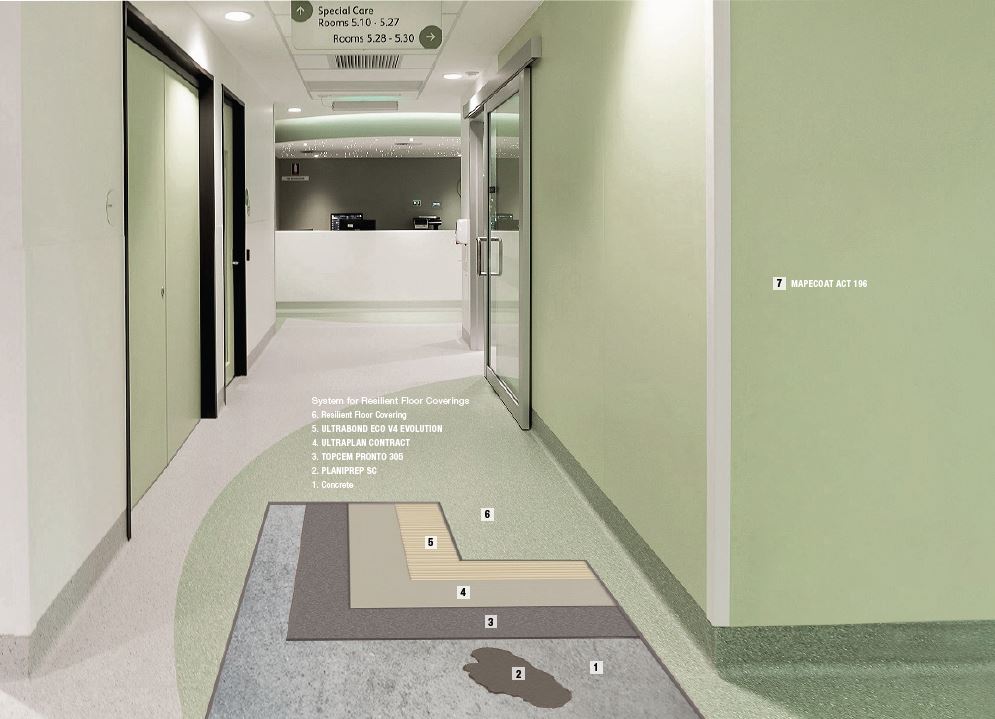
With its extensive products and systems for installing resilient floor in hospital and healthcare centres, Mapei offers the complete solutions with a particular focus on sustainability and properties, as well as ease and speed of installation.
floor screed TOPCEM PRONTO 305; skimming compound PLANIPREP SC; moisture-reduction barrier PLANISEAL VS-MY; self-levelling smoothing compound ULTRAPLAN CONTRACT; universal adhesive for resilient, textile floor & wall coverings ULTRABOND ECO V4 EVOLUTION; semi-gloss enamel for interior walls in healthcare facilities MAPECOAT ACT 196
Strong, dry and flat: the main features you should focus on.
The term “resilient coverings” generally refers to floor and wall coverings made from carpet, rubber or PVC. One of the characteristics they have in common is resilience, a mechanical property that allows these types of material to deform so they can absorb impact loads or deformations without breaking.
What properties should a substrate have to make it suitable for bonding these types of material? Let’s take a close look at three of them.
The first one is high mechanical strength.
Why?
Because most resilient materials do not distribute the loads acting on the floor. The forces pressing down on the surface of resilient floorings are transferred almost directly to the substrate. It isn’t unusual to notice the marks (albeit temporary) left by desks and chairs on PVC flooring. The weight of these objects acts directly on the screed and skimcoat under the flooring.
This is why, according to current standards, the compressive strength of the screed must be a minimum of 15 N/mm2 for floors subjected to pedestrian traffic and 30 N/mm2 for other types of traffic.
The second one is a low level of residual moisture.
Even though this is a common requirement for all substrates and for different types of floor and wall coverings, it becomes even more important in the case of resilient materials. Why? Because PVC and rubber, for example, are essentially impermeable. If the level of moisture in the substrate is too high, they will swell or detach from the surface.
According to current standards, a carbide hygrometer should be used to measure the level of residual moisture in the screed. Going further into detail, the level of residual moisture (R.M.) should be ≤ 2% for cementitious screeds and screeds made from special binders, ≤ 1.7% for heated screeds, ≤ 0.5% for anhydrite (gypsum-based) screeds and ≤ 0.2% for gypsum-based heated screeds.
The third one is flatness.
Taking into consideration the characteristics mentioned above, and considering the compact thickness of resilient materials, if any imperfections or irregularities in the substrate are not eliminated, they show up quite clearly on the surface of the flooring. Flatness, therefore, must be guaranteed by taking special care when making the screed and the prescriptions for installing resilient materials must be adhered to.
A practical way of levelling off the surface of a screed and making it flat is to apply a skimcoat. Skimcoats are generally made from high-strength fast-drying cementitious mortars, often with self-levelling properties (such as ULTRAPLAN MAXI by Mapei).
While the three requirements above are particularly important they are, alas, not the only ones. All those working in this sector know only too well that curing, thickness, compactness, cleanliness and other factors all play their part in the successful outcome of a job.
Marco Albelice. Technical Services, Mapei SpA (Italy)
This line of products includes adhesives, smoothing and levelling compounds and primers for installing resilient and acrylic and polyurethane resin flooring.
![]()
INNOVATION
![]()
ECO-SUSTAINABILITY
![]()
INTERNATIONALITY
For more information, please enquire via email to [email protected]
For some selected products like Novoplan 21 and TopCem Pronto 305, are available in selected hardware stores. Please enquire direct to MAPEI Whatsapp